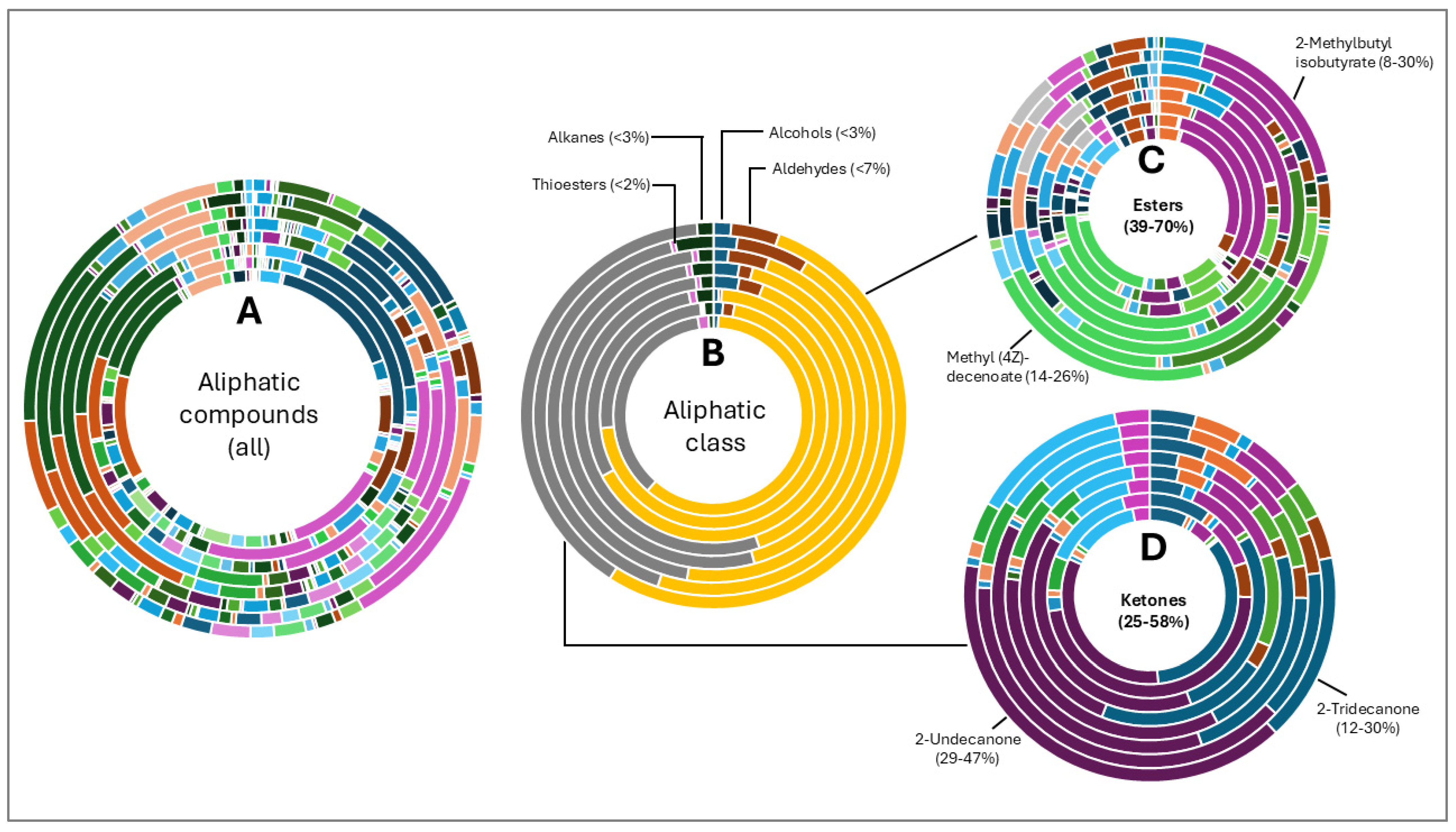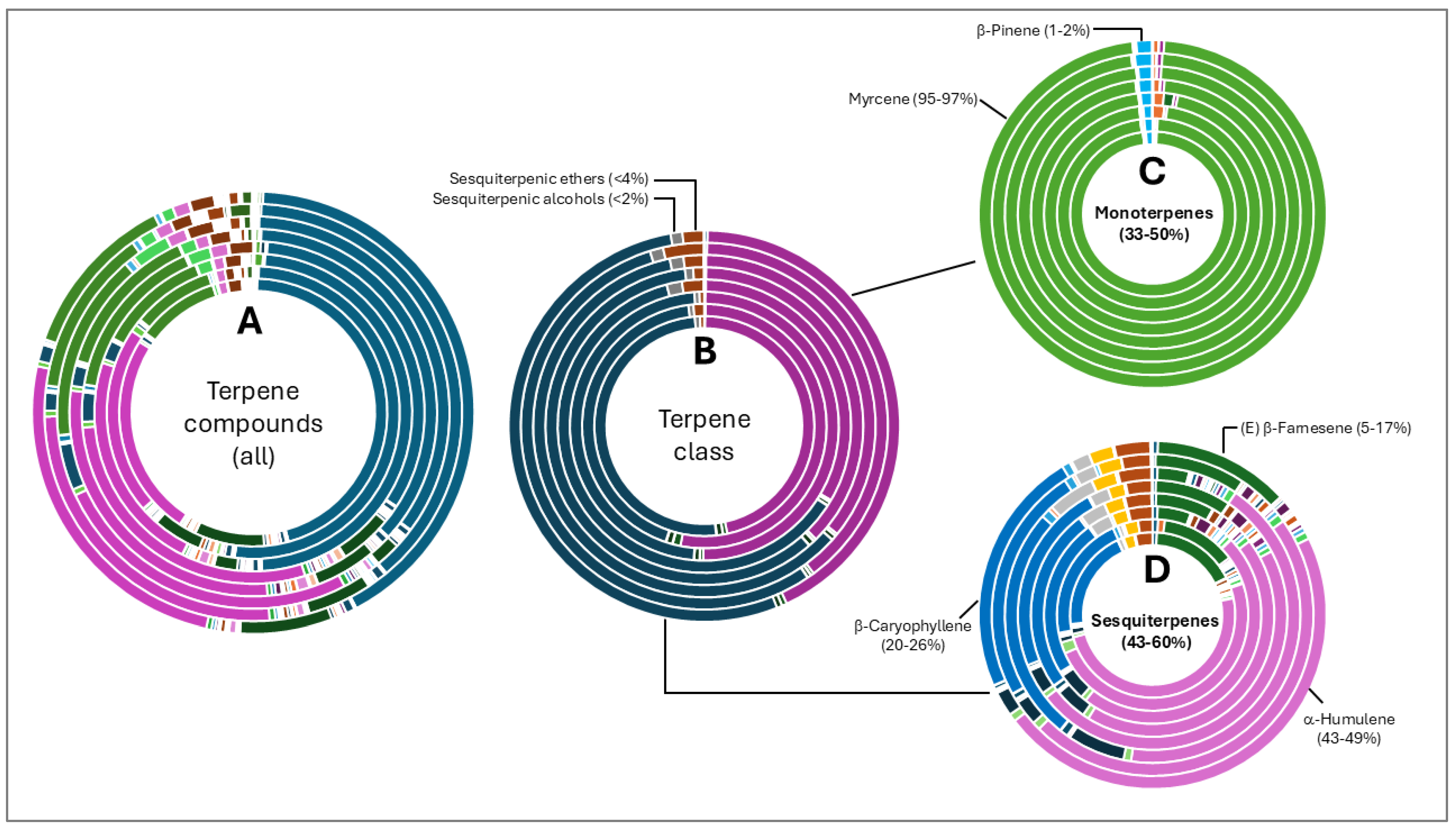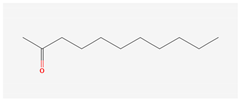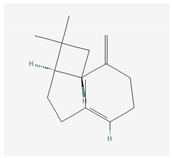Comparison of Major Compounds in Essential Oils Steam Distilled from Fresh Plant Material of South African Hop Varieties
Abstract
1. Introduction
2. Materials and Methods
2.1. Sampling Area and Hop Varieties
2.2. Oil Distillation and Processing
2.3. Physicochemical Measurements and Gas Chromatography Analyses
2.4. Data Processing
3. Results
4. Discussion
4.1. Chemical Profiling
4.2. Bioactivity and Toxicity
4.2.1. Aliphatic Esters and -Ketones
4.2.2. Terpenes
Monoterpenes
Sesquiterpenes
4.3. Uses of Hop Oils
5. Conclusions
Supplementary Materials
Author Contributions
Funding
Institutional Review Board Statement
Informed Consent Statement
Data Availability Statement
Acknowledgments
Conflicts of Interest
References
- Cadar, R.L.; Amuza, A.; Dumitras, D.E.; Mihai, M.; Pocol, C.B. Analysing Clusters of Consumers Who Use Medicinal and Aromatic Plant Products. Sustainability 2021, 13, 8648. [Google Scholar] [CrossRef]
- Żukowska, G.; Durczyńska, Z. Properties and Applications of Essential Oils: A Review. J. Ecol. Eng. 2024, 25, 333–340. [Google Scholar]
- Chiocchio, I.; Mandrone, M.; Tomasi, P.; Marincich, L.; Poli, F. Plant Secondary Metabolites: An Opportunity for Circular Economy. Molecules 2021, 26, 495. [Google Scholar] [CrossRef] [PubMed]
- Dhifi, W.; Bellili, S.; Jazi, S.; Bahloul, N.; Mnif, W. Essential Oils’ Chemical Characterization and Investigation of Some Biological Activities: A Critical Review. Medicines 2016, 3, 25. [Google Scholar] [CrossRef] [PubMed]
- Baptista-Silva, S.; Borges, S.; Ramos, O.L.; Pintado, M.; Sarmento, B. The Progress of Essential Oils as Potential Therapeutic Agents: A Review. J. Essent. Oil Res. 2020, 32, 279–295. [Google Scholar] [CrossRef]
- Sadgrove, N.J.; Padilla-González, G.F.; Phumthum, M. Fundamental Chemistry of Essential Oils and Volatile Organic Compounds, Methods of Analysis and Authentication. Plants 2022, 11, 789. [Google Scholar] [CrossRef] [PubMed]
- de Sousa, D.P.; de Assis Oliveira, F.; Arcanjo, D.D.R.; da Fonsêca, D.V.; Duarte, A.B.S.; de Oliveira Barbosa, C.; Ong, T.P.; Brocksom, T.J. Essential Oils: Chemistry and Pharmacological Activities—Part II. Biomedicines 2024, 12, 1185. [Google Scholar] [CrossRef]
- Sharmeen, J.B.; Mahomoodally, F.M.; Zengin, G.; Maggi, F. Essential Oils as Natural Sources of Fragrance Compounds for Cosmetics and Cosmeceuticals. Molecules 2021, 26, 666. [Google Scholar] [CrossRef] [PubMed]
- Djilani, A.; Dicko, A. The Therapeutic Benefits of Essential Oils. In Nutrition, Well-Being and Health; Bouayed, J., Bohn, T., Eds.; IntechOpen Limited: London, UK, 2012; pp. 155–178. [Google Scholar]
- Pieracci, Y.; Ascrizzi, R.; Terreni, V.; Pistelli, L.; Flamini, G.; Bassolino, L.; Fulvio, F.; Montanari, M.; Paris, R. Essential Oil of Cannabis Sativa l: Comparison of Yield and Chemical Composition of 11 Hemp Genotypes. Molecules 2021, 26, 4080. [Google Scholar] [CrossRef] [PubMed]
- Anywar, G.; Kakudidi, E.; Tugume, P.; Asiimwe, S. The Cannabis/Marijuana (Cannabis Sativa L.) Landscape in Africa: An Overview of Its Cultivation and Legal Aspects. In Cannabis/Hemp for Sustainable Agriculture and Materials; Agrawal, D.C., Kumar, R., Dhanasekaran, M., Eds.; Springer Nature: Singapore, 2022; pp. 297–310. [Google Scholar]
- SAHPRA—South African Health Products Regulatory Authority. Guideline for Cultivation of Cannabis and Manufacture of Cannabis-Related Pharmaceutical Products for Medicinal and Research Purpose; Arcadia: Pretoria, South Africa, 2022; pp. 1–34. [Google Scholar]
- Ovidi, E.; Laghezza Masci, V.; Taddei, A.R.; Torresi, J.; Tomassi, W.; Iannone, M.; Tiezzi, A.; Maggi, F.; Garzoli, S. Hemp (Cannabis Sativa L., Kompolti Cv.) and Hop (Humulus Lupulus L., Chinook Cv.) Essential Oil and Hydrolate: HS-GC-MS Chemical Investigation and Apoptotic Activity Evaluation. Pharmaceuticals 2022, 15, 976. [Google Scholar] [CrossRef] [PubMed]
- Hrnčič, M.K.; Španinger, E.; Košir, I.J.; Knez, Ž.; Bren, U. Hop Compounds: Extraction Techniques, Chemical Analyses, Antioxidative, Antimicrobial, and Anticarcinogenic Effects. Nutrients 2019, 11, 257. [Google Scholar] [CrossRef] [PubMed]
- Sabbatini, G.; Mari, E.; Ortore, M.G.; Di Gregorio, A.; Fattorini, D.; Di Carlo, M.; Galeazzi, R.; Vignaroli, C.; Simoni, S.; Giorgini, G.; et al. Hop Leaves: From Waste to a Valuable Source of Bioactive Compounds—A Multidisciplinary Approach to Investigating Potential Applications. Heliyon 2024, 10, e37593. [Google Scholar] [CrossRef]
- Biendl, M. Hops and Health. In Technical Quarterly Volume 46; Master Brewers Association of the Americas: St. Paul, MN, USA, 2009. [Google Scholar] [CrossRef]
- Karabín, M.; Hudcová, T.; Jelínek, L.; Dostálek, P. Biologically Active Compounds from Hops and Prospects for Their Use. Compr. Rev. Food Sci. Food Saf. 2016, 15, 542–567. [Google Scholar] [CrossRef]
- Korpelainen, H.; Pietiläinen, M. Hop (Humulus lupulus L.): Traditional and Present Use, and Future Potential. Econ. Bot. 2021, 75, 302–322. [Google Scholar] [CrossRef]
- Koen, J.H.; Breytenbach, W. Ant Species Richness of Fynbos and Forest Ecosystems in the Southern Cape. S. Afr. Tydskr. Dierk. 1988, 23, 184–188. [Google Scholar] [CrossRef][Green Version]
- du Plessis. W Standards or Operation Preserve Botanica Hop Harvest 2023. pp. 1–22.
- Volpini-Klein, A.F.N.; Lima Júnior, S.E.; Cardoso, C.A.L.; Cabral, M.R.P.; Louro, G.M.; Coutinho, E.J.; de Jesus, D.A.; Junior, D.P.; Simionatto, E. Chemical Composition of Essential Oils from Leaves and Fruits of Schinus molle Obtained by Different Extraction Methods (Hydrodistillation, Fractional Hydrodistillation and Steam Distillation) and Seasonal Variations. J. Essent. Oil-Bear. Plants 2021, 24, 228–242. [Google Scholar] [CrossRef]
- ISO/IEC 17025:2017; General Requirements for the Competence of Testing and Calibration Laboratories. International Organization for Standardization: Geneva, Switzerland, 2017.
- Mercier, S.; Lorenzo, R.Y.; Pichette, A.; Côté, H.; Legault, J.; St-Gelais, A. Pili Tree (Canarium ovatum) Resin’s Antibacterial Essential Oil and Hydrosol as Rich Sources of (S)-Phellandrenes Derivatives. Chem. Biodivers. 2020, 17, e2000561. [Google Scholar] [CrossRef]
- Adams, T.B.; Gavin, C.L.; McGowen, M.M.; Waddell, W.J.; Cohen, S.M.; Feron, V.J.; Marnett, L.J.; Munro, I.C.; Portoghese, P.S.; Rietjens, I.M.C.M.; et al. The FEMA GRAS Assessment of Aliphatic and Aromatic Terpene Hydrocarbons Used as Flavor Ingredients. Food Chem. Toxicol. 2011, 49, 2471–2494. [Google Scholar] [CrossRef]
- SAEOPA—Southern African Essential Oils Producers Association. Testing of the Quality of Essential and Vegetable Oils; UNIDO: Vienna, Austria, 2023; pp. 1–26. [Google Scholar]
- Kim, S.; Chen, J.; Cheng, T.; Gindulyte, A.; He, J.; He, S.; Li, Q.; Shoemaker, B.A.; Thiessen, P.A.; Yu, B.; et al. PubChem 2023 Update. Nucleic Acids Res. 2023, 51, D1373–D1380. [Google Scholar] [CrossRef] [PubMed]
- ECHA Methyl Decanoate Registration Dossier. 2023. Available online: https://echa.europa.eu/registration-dossier/-/registered-dossier/16051/7/2/1 (accessed on 12 November 2024).
- Opinion of the Scientific Panel on Food Additives, Flavourings, Processing Aids and Materials in Contact with Food (AFC) Related to Flavouring Group Evaluation 6 (FGE.06): Straight-and Branched-Chain Aliphatic Unsatured Primary Alcohols, Aldehydes, Carboxylic Acids, and Esters from Chemical Groups 1 and 4. EFSA J. 2004, 2, 1–69. [CrossRef]
- Hänsel, R.; Wohlfart, R.; Coper, H. Sedative-Hypnotic Compounds in the Exhalation of Hops. Z. Naturforsch C Biosci. 1980, 35, 1096–1097. [Google Scholar] [CrossRef] [PubMed]
- Api, A.M.; Belsito, D.; Botelho, D.; Bruze, M.; Burton, G.A.; Buschmann, J.; Dagli, M.L.; Date, M.; Dekant, W.; Deodhar, C.; et al. RIFM Fragrance Ingredient Safety Assessment, 2-Undecanone, CAS Registry Number 112-12-9. Food Chem. Toxicol. 2019, 134, 110634. [Google Scholar] [CrossRef]
- Api, A.M.; Belsito, D.; Botelho, D.; Bruze, M.; Burton, G.A.; Cancellieri, M.A.; Chon, H.; Dagli, M.L.; Date, M.; Dekant, W.; et al. RIFM Fragrance Ingredient Safety Assessment, 2-Tridecanone, CAS Registry Number 593-08-8. Food Chem. Toxicol. 2022, 169, 113408. [Google Scholar] [CrossRef]
- Api, A.M.; Belmonte, F.; Belsito, D.; Biserta, S.; Botelho, D.; Bruze, M.; Burton, G.A.; Buschmann, J.; Cancellieri, M.A.; Dagli, M.L.; et al. RIFM Fragrance Ingredient Safety Assessment, Myrcene, CAS Registry Number 123-35-3. Food Chem. Toxicol. 2020, 144, 111631. [Google Scholar] [CrossRef] [PubMed]
- Dascalu, D.; Isvoran, A.; Ianovici, N. Predictions of the Biological Effects of Several Acyclic Monoterpenes as Chemical Constituents of Essential Oils Extracted from Plants. Molecules 2023, 28, 4640. [Google Scholar] [CrossRef] [PubMed]
- Lavoie, E.J.; Adams, J.D.; Reinhardt, J.; Rivenson, A.; Hoffmann, D. Toxicity Studies on Clove Cigarette Smoke and Constituents of Clove: Determination of the LDs0 of Eugenol by Intratracheal Instillation in Rats and Hamsters. Arch. Toxicol. 1986, 59, 78–81. [Google Scholar] [CrossRef] [PubMed]
- Mendes de Lacerda Leite, G.; de Oliveira Barbosa, M.; Pereira Lopes, M.J.; de Araújo Delmondes, G.; Bezerra, D.S.; Araújo, I.M.; Carvalho de Alencar, C.D.; Melo Coutinho, H.D.; Peixoto, L.R.; Barbosa-Filho, J.M.; et al. Pharmacological and Toxicological Activities of α-Humulene and Its Isomers: A Systematic Review. Trends Food Sci. Technol. 2021, 115, 255–274. [Google Scholar] [CrossRef]
- Api, A.M.; Belsito, D.; Botelho, D.; Bruze, M.; Burton, G.A.; Buschmann, J.; Cancellieri, M.A.; Dagli, M.L.; Date, M.; Dekant, W.; et al. RIFM Fragrance Ingredient Safety Assessment, β-Caryophyllene, CAS Registry Number 87-44-5. Food Chem. Toxicol. 2022, 159, 112707. [Google Scholar] [CrossRef] [PubMed]
- Api, A.M.; Belsito, D.; Botelho, D.; Bruze, M.; Burton, G.A.; Buschmann, J.; Cancellieri, M.A.; Dagli, M.L.; Date, M.; Dekant, W.; et al. RIFM Fragrance Ingredient Safety Assessment, Bisabolene, CAS Registry Number 495-62-5. Food Chem. Toxicol. 2022, 163, 112953. [Google Scholar] [CrossRef] [PubMed]
- Çelik, K.; Toǧar, B.; Türkez, H.; Taşpinar, N. In Vitro Cytotoxic, Genotoxic, and Oxidative Effects of Acyclic Sesquiterpene Farnesene. Turk. J. Biol. 2014, 38, 253–259. [Google Scholar] [CrossRef]
- da Rosa Almeida, A.; Maciel, M.V.D.O.B.; Cardoso Gasparini Gandolpho, B.; Machado, M.H.; Teixeira, G.L.; Bertoldi, F.C.; Noronha, C.M.; Vitali, L.; Block, J.M.; Barreto, P.L.M. Brazilian Grown Cascade Hop (Humulus Lupulus L.): LC-ESI-MS-MS and GC-MS Analysis of Chemical Composition and Antioxidant Activity of Extracts and Essential Oils. J. Am. Soc. Brew. Chem. 2021, 79, 156–166. [Google Scholar] [CrossRef]
- Móricz, Á.M.; Bartoszek, M.; Polak, J.; Marczewska, P.; Knaś, M.; Böszörményi, A.; Fodor, J.; Kowalska, T.; Sajewicz, M. A Comparison of Quantitative Composition and Bioactivity of Oils Derived from Seven North American Varieties of Hops (Humulus lupulus L.). Separations 2023, 10, 402. [Google Scholar] [CrossRef]
- Piasecki, B.; Biernasiuk, A.; Ludwiczuk, A. Anti-Coccal Activity and Composition of the Essential Oils and Methanolic Extracts Obtained from Brewing Quality Humulus Lupulus L. Hop Pellets. Pharmaceuticals 2023, 16, 1098. [Google Scholar] [CrossRef] [PubMed]
- Duarte, P.F.; do Nascimento, L.H.; Bandiera, V.J.; Fischer, B.; Fernandes, I.A.; Paroul, N.; Junges, A. Exploring the Versatility of Hop Essential Oil (Humulus Lupulus L.): Bridging Brewing Traditions with Modern Industry Applications. Ind. Crops Prod. 2024, 218, 118974. [Google Scholar] [CrossRef]
- Becker, L.; Boyer, I.; Bergfeld, W.F.; Belsito, D.V.; Hill, R.A.; Klaassen, C.D.; Liebler, D.C.; Marks, J.G.; Shank, R.C.; Slaga, T.J.; et al. Safety Assessment of Hops as Used in Cosmetics. Int. J. Toxicol. 2024, 43, 5S–29S. [Google Scholar] [CrossRef]
- Fischer, B.; Gevinski, E.V.; da Silva, D.M.; Júnior, P.A.L.; Bandiera, V.J.; Lohmann, A.M.; Rigo, D.; Duarte, P.F.; Franceschi, E.; Zandoná, G.P.; et al. Extraction of Hops Pelletized (Humulus lupulus) with Subcritical CO2 and Hydrodistillation: Chemical Composition Identification, Kinetic Model, and Evaluation of Antioxidant and Antimicrobial Activity. Food Res. Int. 2023, 167, 112712. [Google Scholar] [CrossRef] [PubMed]
- Mongelli, A.; Rodolfi, M.; Ganino, T.; Marieschi, M.; Caligiani, A.; Dall’Asta, C.; Bruni, R. Are Humulus Lupulus L. Ecotypes and Cultivars Suitable for the Cultivation of Aromatic Hop in Italy? A Phytochemical Approach. Ind. Crops Prod. 2016, 83, 693–700. [Google Scholar] [CrossRef]
- Połeć, K.; Broniatowski, M.; Wydro, P.; Hąc-Wydro, K. The Impact of β-Myrcene—the Main Component of the Hop Essential Oil—On the Lipid Films. J. Mol. Liq. 2020, 308. [Google Scholar] [CrossRef]
- Hagemann, M.H.; Rigling, M.; Mannweiler, S.; Born, U.; Sprich, E.; Milyaev, A.; Zhang, Y. Insight into the Aroma Quality of ‘Callista’ Cultivar of Hop (Humulus Lupulus L.): Impact of Harvest Timing, Year, and Location. Food Res. Int. 2024, 175, 113776. [Google Scholar] [CrossRef]
- Almaguer, C.; Schönberger, C.; Gastl, M.; Arendt, E.K.; Becker, T. Humulus lupulus—A Story That Begs to Be Told. A Review. J. Inst. Brew. 2014, 120, 289–314. [Google Scholar] [CrossRef]
- Nazir, I.; Ahmad Gangoo, S. Pharmaceutical and Therapeutic Potentials of Essential Oils. In Essential Oils—Advances in Extraction and Biological Applications; Santana de Oliveira, M., de Aguiar Andrade, E.H., Eds.; BoD–Books on Demand: Schleswig-Holstein, Germany, 2022. [Google Scholar] [CrossRef]
- Rutnik, K.; Knez Hrnčič, M.; Jože Košir, I. Hop Essential Oil: Chemical Composition, Extraction, Analysis, and Applications. Food Rev. Int. 2022, 38, 529–551. [Google Scholar] [CrossRef]
- Dietz, C.; Cook, D.; Huismann, M.; Wilson, C.; Ford, R. The Multisensory Perception of Hop Essential Oil: A Review. J. Inst. Brew. 2020, 126, 320–342. [Google Scholar]
- Eyres, G.; Dufour, J. Hop Essential Oil: Analysis, Chemical Composition and Odor Characteristics. In Beer in Health and Disease Prevention; Preedy, V.R., Ed.; Elsevier Science: Amsterdam, The Netherlands, 2009; pp. 239–254. [Google Scholar]
- Antoniadou, M.; Varzakas, T. Editorial: Special Issue “Microbial Diversity of Fermented Food”. Microorganisms 2023, 11, 1219. [Google Scholar] [CrossRef] [PubMed]
- Gibka, J.; Wasiutyński, A.; Skopińska-Różewska, E.; Siwicki, A.K.; Chorostowska-Wynimko, J.; Sommer, E.; Mazurkiewicz, M.; Gliński, M.; Skurzak, H.; Wójcik, R.; et al. The Effect of Undecanones and Their Derivatives on Tumor Angiogenesis and VEGF Content. Pol. J. Vet. Sci. 2010, 13, 105–115. [Google Scholar]
- Jiao, Y.; Wang, S.; Jiang, L.; Sun, X.; Li, J.; Liu, X.; Yao, X.; Zhang, C.; Wang, N.; Deng, H.; et al. 2-Undecanone Protects against Fine Particles-Induced Heart Inflammation via Modulating Nrf2/HO-1 and NF-ΚB Pathways. Env. Toxicol. 2022, 37, 1642–1652. [Google Scholar] [CrossRef] [PubMed]
- Wu, X.; Li, J.; Wang, S.; Jiang, L.; Sun, X.; Liu, X.; Yao, X.; Zhang, C.; Wang, N.; Yang, G. 2-Undecanone Protects against Fine Particle-Induced Kidney Inflammation via Inducing Mitophagy. J. Agric. Food Chem. 2021, 69, 5206–5215. [Google Scholar] [CrossRef] [PubMed]
- Del Prado-Audelo, M.L.; Cortés, H.; Caballero-Florán, I.H.; González-Torres, M.; Escutia-Guadarrama, L.; Bernal-Chávez, S.A.; Giraldo-Gomez, D.M.; Magaña, J.J.; Leyva-Gómez, G. Therapeutic Applications of Terpenes on Inflammatory Diseases. Front. Pharmacol. 2021, 12, 704197. [Google Scholar] [CrossRef] [PubMed]
- Masyita, A.; Mustika Sari, R.; Dwi Astuti, A.; Yasir, B.; Rahma Rumata, N.; Emran, T.B.; Nainu, F.; Simal-Gandara, J. Terpenes and Terpenoids as Main Bioactive Compounds of Essential Oils, Their Roles in Human Health and Potential Application as Natural Food Preservatives. Food Chem. X 2022, 13, 100217. [Google Scholar] [CrossRef]
- Bizaj, K.; Škerget, M.; Košir, I.J.; Knez, Ž. Hop (Humulus lupulus L.) Essential Oils and Xanthohumol Derived from Extraction Process Using Solvents of Different Polarity. Horticulturae 2022, 8, 368. [Google Scholar] [CrossRef]
- Nuutinen, T. Medicinal Properties of Terpenes Found in Cannabis sativa and Humulus Lupulus. Eur. J. Med. Chem. 2018, 157, 198–228. [Google Scholar] [CrossRef] [PubMed]
- Felter, S.P.; Llewelyn, C.; Navarro, L.; Zhang, X. How the 62-Year Old Delaney Clause Continues to Thwart Science: Case Study of the Flavor Substance β-Myrcene. Regul. Toxicol. Pharmacol. 2020, 115, 104708. [Google Scholar] [CrossRef]
- Food Chemicals Codex, 9th ed.; Deutscher Apotheker Verlag: Stuttgart, Germany, 2014; ISBN 3769262352.
- Hashiesh, H.M.; Sharma, C.; Goyal, S.N.; Sadek, B.; Jha, N.K.; Kaabi, J.A.; Ojha, S. A Focused Review on CB2 Receptor-Selective Pharmacological Properties and Therapeutic Potential of β-Caryophyllene, a Dietary Cannabinoid. Biomed. Pharmacother. 2021, 140, 111639. [Google Scholar] [CrossRef] [PubMed]
- Meeran, M.F.N.; Al Taee, H.; Azimullah, S.; Tariq, S.; Adeghate, E.; Ojha, S. β-Caryophyllene, a Natural Bicyclic Sesquiterpene Attenuates Doxorubicin-Induced Chronic Cardiotoxicity via Activation of Myocardial Cannabinoid Type-2 (CB2) Receptors in Rats. Chem. Biol. Interact. 2019, 304, 158–167. [Google Scholar] [CrossRef] [PubMed]
- Wang, X.; Meng, F.; Mao, J. Progress of Natural Sesquiterpenoids in the Treatment of Hepatocellular Carcinoma. Front. Oncol. 2024, 14, 1445222. [Google Scholar] [CrossRef]
- Segat, G.C.; Manjavachi, M.N.; Matias, D.O.; Passos, G.F.; Freitas, C.S.; Costa, R.; Calixto, J.B. Antiallodynic Effect of β-Caryophyllene on Paclitaxel-Induced Peripheral Neuropathy in Mice. Neuropharmacology 2017, 125, 207–219. [Google Scholar] [CrossRef] [PubMed]
- Gertsch, J.; Leonti, M.; Raduner, S.; Racz, I.; Chen, J.-Z.; Xie, X.-Q.; Altmann, K.-H.; Karsak, M.; Zimmer, A. Beta-Caryophyllene Is a Dietary Cannabinoid. Proc. Natl. Acad. Sci. USA 2008, 105, 9099–9104. [Google Scholar] [CrossRef]
- Jiang, H.; Zhong, S.; Schwarz, P.; Chen, B.; Rao, J. Antifungal Activity, Mycotoxin Inhibitory Efficacy, and Mode of Action of Hop Essential Oil Nanoemulsion against Fusarium Graminearum. Food Chem. 2023, 400, 134016. [Google Scholar] [CrossRef] [PubMed]
- Lazarević, J.; Aćimović, M.; Pezo, L.; Lončar, B.; Konstantinović, B.; Popov, M.; Šovljanski, O.; Travičić, V.; Sikora, V.; Vujisić, L. Chemical Composition and In Vitro Biological Activity of Angelica Root and Hop Strobile Essential Oils and Hydrolates. Waste Biomass Valorization 2024, 15, 867–883. [Google Scholar] [CrossRef]
- Carbone, K.; Gervasi, F. An Updated Review of the Genus Humulus: A Valuable Source of Bioactive Compounds for Health and Disease Prevention. Plants 2022, 11, 3434. [Google Scholar] [CrossRef]




| Functional Group | Fraction (%) in Hop Varieties | |||||||
|---|---|---|---|---|---|---|---|---|
| Queen | XJA2/436 | Sublime | Aroma | Dawn | Passion | Promise | Star | |
| Alcohols | 1.29 | 1.65 | 0.95 | 1.89 | 1.16 | 1.43 | 1.40 | 1.31 |
| Aldehydes | 0.04 | 0.11 | 0.06 | 0.21 | 0.14 | 0.21 | 0.48 | 0.26 |
| Ethers | 0.61 | 1.41 | 0.53 | 2.16 | 1.01 | 1.68 | 3.13 | 1.58 |
| Esters | 4.74 | 3.36 | 5.64 | 2.94 | 3.39 | 2.81 | 3.56 | 3.61 |
| Ketones | 2.25 | 0.91 | 2.24 | 3.52 | 3.51 | 2.36 | 2.90 | 2.41 |
| Terpenes | 86.93 | 89.81 | 85.94 | 83.97 | 85.88 | 84.80 | 82.20 | 85.81 |
| Refractive index * | 1.481 | 1.482 | 1.480 | 1.486 | 1.485 | 1.485 | 1.486 | 1.483 |
| Compound, IUPAC Name, (Class), & Chemical Structure | Compound Summary | Toxicology | Fractions (%) in Hop Oils from This Study |
|---|---|---|---|
| Methyl (4Z) decenoate Synonym: Methyl E-4-decenoate IUPAC: Methyl (Z)-4-decenoate (Aliphatic ester)  | CAS-No: 93979-14-7 Formula: C11H20O2 Molecular Weight: 184.27 g/mol PubChem ID: CID 5366840 | No acute oral, dermal or inhalation toxicity, or skin or eye irritation, or skin sensitisation were noted. No treatment-related effects were noted up to and including the limit dose of 1000 mg/kg bw/day after repeated oral exposure [27]. (in vivo) Estimated MSDI of 0.0012 µg/person/day with a threshold concern at 1800 µg/person/day [28]. | African Queen: 0.74% Southern Star: 0.72% Southern Sublime: 0.69% Southern Dawn: 0.65% Southern Passion: 0.63% Southern Aroma: 0.61%% Southern Promise: 0.59% XJA2/436: 0.42% |
| 2-Methylbutyl isobutyrate IUPAC: 2-methylbutyl 2-methylpropanoate (Aliphatic ester)  | CAS-No: 2445-69-4 Formula: C9H18O2 Molecular Weight: 158.24 g/mol PubChem ID: CID 97883 | When given to mice at a dose of 0.80 g/kg, narcosis is produced for about 8 h [29]. (in vivo) Estimated MSDI of 1.4 µg/person/day with a threshold concern at 1800 µg/person/day [28]. | Southern Sublime: 1.35% African Queen: 0.98% XJA2/436: 0.77% Southern Star: 0.56% Southern Dawn: 0.52% Southern Promise: 0.43% Southern Aroma: 0.30% Southern Passion: 0.20% |
| 2-Undecanone IUPAC: undecan-2-one (Aliphatic ketone)  | CAS-No: 112-12-9 Formula: C11H22O Molecular Weight: 170.29 g/mol PubChem ID: CID 8163 | * Insufficient toxicity data: analogue = 2-heptanone (CAS # 110- 43-0) Genotoxicity: not expected (in vitro and in vivo) Repeated Dose Toxicity: NOAEL = 1087 mg/kg/day (in vivo) Skin Sensitisation: not a concern (in vivo) Local Respiratory Toxicity: No NOAEC available. Exposure is below the TTC (0.47 mg/day) Reference: [30] | Southern Dawn: 1.21% Southern Promise: 1.11% Southern Aroma: 0.99% Southern Star: 0.94% Southern Sublime: 0.88% Southern Passion: 0.87% African Queen: 0.75% XJA2/436: 0.43% |
| 2-Tridecanone IUPAC: tridecan-2-one (Aliphatic ketone)  | CAS-No: 593-08-8 Formula: C13H26O Molecular Weight: 198.34 g/mol PubChem ID: CID 11622 | * Insufficient toxicity data: analogue = 2-heptanone (CAS # 110- 43-0) Genotoxicity: not expected (in vitro) Repeated dose toxicity: NOEL = 20 mg/kg/day (in vivo) Skin sensitisation: not a concern (in vivo, human) Respiratory toxicity: No NOAEC available. Exposure is below TTC (0.47 mg/day) Reference: [31] | African Queen: 0.77% Southern Dawn: 0.76% Southern Aroma: 0.75% Southern Sublime: 0.62% Southern Passion: 0.44% Southern Promise: 0.40% Southern Star: 0.39% XJA2/436: 0% |
| Myrcene IUPAC: 7-methyl-3-methylideneocta-1,6-diene (Monoterpene)  | CAS-No: 123-35-3 Formula: C10H16 Molecular Weight: 136.23 g/mol PubChem ID: CID 31253 | Genotoxicity: Not expected (in vivo) Repeated Dose Toxicity: NOAEL = 25 mg/kg/day (in vivo) Skin Sensitisation: None (in vivo) Local Respiratory Toxicity: No NOAEC available. Exposure is below the TTC. (1.4 mg/day) (in vivo) References: [32,33] | XJA2/436: 48.15% Southern Sublime: 42.15% African Queen: 40.57% Southern Star: 37% Southern Promise: 33.35% Southern Dawn: 31.94% Southern Passion: 30.65% Southern Aroma: 27.80% |
| α-Humulene IUPAC: (1Z,4Z,8E)-2,6,6,9-tetramethylcycloundeca-1,4,8-triene (Sesquiterpene)  | CAS-No: 6753-98-6 Formula: C15H24 Molecular Weight: 204.35 g/mol PubChem ID: CID 5281520 | No RIFM toxicity review available. A single study by LeVoie et al. [34] noting marginal toxicity in rats exposed to clove smoke, highlighted in a recent review by Mendes de Lacerda Leite et al. [35]. | Southern Dawn: 24.89% Southern Aroma: 24.07% Southern Passion: 22.75% Southern Promise: 22.54% Southern Star: 22.21% African Queen: 22.05% Southern Sublime: 19.96% XJA2/436: 19.52% |
| β-Caryophyllene IUPAC: (1R,4E,9S)-4,11,11-trimethyl-8-methylidenebicyclo [7.2.0] undec-4-ene (Sesquiterpene)  | CAS-No: 87-44-5 Formula: C15H24 Molecular Weight: 204.35 g/mol PubChem ID: CID 5281515 | Genotoxicity: None (in vivo and in vitro) Repeated Dose Toxicity: NOAEL = 1033 mg/kg/day (in vivo) Skin Sensitisation: None (in vivo also human) Local Respiratory Toxicity: No NOAEC available. Exposure is below the TTC (1.4 mg/day) (in vivo, human) Reference: [36] | Southern Passion: 13.73% Southern Aroma: 13.36% Southern Dawn: 12.15% Southern Promise: 11.38% Southern Star: 10.87% Southern Sublime: 9.94% African Queen: 8.93% XJA2/436: 8.47% |
| β-Farnesene (E)-7,11-dimethyl-3-methylenedodeca-1,6,10-triene (Sesquiterpene)  | CAS-No: 18794-84-8 Formula: C15H24 Molecular Weight: 204.35 g/mol PubChem ID: CID 5281517 | Genotoxicity: Not expected (in vitro) Repeated Dose Toxicity: No NOAEL available. Exposure is below the TTC (0.03 mg/g/day) (insufficient data available) Skin Sensitisation: NESIL = 3.7 mg/cm2 (in vivo and human studies) Local Respiratory Toxicity: No NOAEC available. Insufficient inhalation data available. Exposure is below the TTC (1.4 mg/day). References: [37,38] | African Queen: 7.57% Southern Star: 6% XJA2/436: 5.11% Southern Dawn: 4.82% Southern Promise: 4.34% Southern Aroma: 4.23% Southern Sublime: 2.08% Southern Passion: 1.84% |
Disclaimer/Publisher’s Note: The statements, opinions and data contained in all publications are solely those of the individual author(s) and contributor(s) and not of MDPI and/or the editor(s). MDPI and/or the editor(s) disclaim responsibility for any injury to people or property resulting from any ideas, methods, instructions or products referred to in the content. |
© 2025 by the authors. Licensee MDPI, Basel, Switzerland. This article is an open access article distributed under the terms and conditions of the Creative Commons Attribution (CC BY) license (https://creativecommons.org/licenses/by/4.0/).
Share and Cite
de Smidt, O.; du Plessis, W.; Zacharia, P.R.; Manduna, I.T. Comparison of Major Compounds in Essential Oils Steam Distilled from Fresh Plant Material of South African Hop Varieties. Life 2025, 15, 282. https://doi.org/10.3390/life15020282
de Smidt O, du Plessis W, Zacharia PR, Manduna IT. Comparison of Major Compounds in Essential Oils Steam Distilled from Fresh Plant Material of South African Hop Varieties. Life. 2025; 15(2):282. https://doi.org/10.3390/life15020282
Chicago/Turabian Stylede Smidt, Olga, Wanda du Plessis, Puleng Rose Zacharia, and Idah Tichaidza Manduna. 2025. "Comparison of Major Compounds in Essential Oils Steam Distilled from Fresh Plant Material of South African Hop Varieties" Life 15, no. 2: 282. https://doi.org/10.3390/life15020282
APA Stylede Smidt, O., du Plessis, W., Zacharia, P. R., & Manduna, I. T. (2025). Comparison of Major Compounds in Essential Oils Steam Distilled from Fresh Plant Material of South African Hop Varieties. Life, 15(2), 282. https://doi.org/10.3390/life15020282






